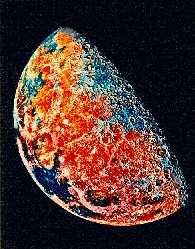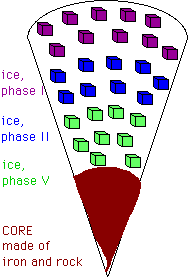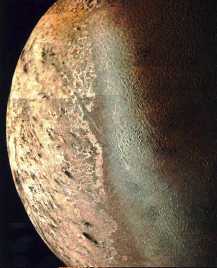This is an image of Triton.
Click on image for full size
NASA
Triton Composition
When the
Voyager mission flew by Triton, it took the
spectra of the surface. The spectra matched that of ice and also several different kinds of snow (crushed ice).
The Voyager spacecraft could not measure the interior of the moons, however. A good guess is that Triton is made of ice throughout it's interior, except for a small core of rocky material at the center. There may be a small layer of water inside Triton too, however this depends upon whether the inside of Triton is warm. A small layer of water could provide an environment for life. Only more exploration will help us know for sure if these things are possible.
The fact that this moon is made primarily of ice suggests a certain path for it's history.
You might also be interested in:

How did life evolve on Earth? The answer to this question can help us understand our past and prepare for our future. Although evolution provides credible and reliable answers, polls show that many people turn away from science, seeking other explanations with which they are more comfortable.
...more
Minerals of a planet's surface, and molecules of an atmosphere give off light of various colors. Some rocks emit more light in the blue end of the spectrum than the red, and so on. These colors are very
...more
The diagram to the left shows a drawing of the possible interior of Triton. The composition of Triton is mostly ice, therefore there is probably a small core of some rocky material buried inside, overlain
...more
Triton is most like Jupiter's moon Europa. Like Europa, the interior of Triton may have been warm enough at one time to contain a liquid layer just under the surface. On Earth, we know that there are some
...more
Triton was discovered by W. Lassell in 1846. Of the 8 moons, it is the 2nd farthest from Neptune, with a standoff distance of 354,800 km. Triton may be one of the largest of the icy moons, is comparable
...more
Neptune has // Call the moon count function defined in the document head print_moon_count('neptune'); moons. It also has rings, but its rings are different from Saturn's. Neptune's largest moon is named
...more
When the Voyager mission flew by Triton, it took the spectra of the surface. The spectra matched that of ice and also several different kinds of snow (crushed ice). The Voyager spacecraft could not measure
...more
This beautiful image of Triton reveals many interesting features of its surface. The surface of Triton is halfway between Ganymede's and Europa's (two of Jupiter's moons). Ancient portions of the surface
...more










